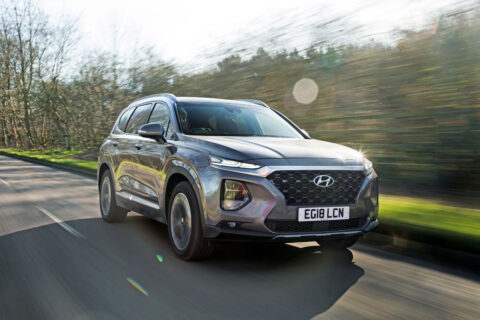
But is it enough to be regarded as one of the best SUVs for families?
Hyundai Santa Fe design & styling
The Santa Fe’s UK market success has, to a significant degree, been built on metal-for-the-money value. And so, while it was already one of the bigger SUVs on which you could spend £30,000-plus, the fact that it’s just got a little bit bigger probably won’t hurt its sales potential.
At 4770mm in length, the car is now within a few inches of a BMW X5, and splits the difference between a Land Rover Discovery and Land Rover Discovery Sport on occupied kerbside real estate almost exactly. And yet, as you might imagine, the Santa Fe is a long way from splitting the difference between those two Land Rovers so precisely on price. More on that in due course.
The car’s underbody construction remains an all-steel monocoque, although it has a greater proportion of hot-stamped, high-strength steel in it than any other Hyundai. The body is suspended independently, via struts up front and multiple links at the rear, above which you’ll find steel coil springs and a damping system that offers a self-levelling function for all UK-market specifications.
Four-wheel drive isn’t likewise standard on all versions; and, what’s more, this is the first time that Hyundai UK has offered a front-driven Santa Fe – although not the first time that the car has been without rear driveshafts in a global sense. There is, for now, only one engine on offer: a redesigned version of Hyundai’s ‘R’-family 2199cc CRDi turbodiesel four-cylinder motor, which mounts transversely under the bonnet and produces 197bhp and 325lb ft.
In both cases, that’s precisely what the outgoing Santa Fe had – although Hyundai’s engineers may well have considered it a good result to reproduce those outputs on an engine that’s needed revised combustion control, reduced internal friction, a particulate trap, a selective catalytic reduction system and a lean NOx trap to satisfy current Euro 6d-TEMP emissions requirements.
Buyers can opt for a six-speed manual or eight-speed automatic gearbox regardless of their choice on number of driven wheels – and if they do go for four-wheel drive, as was fitted to our top-of-the-range automatic test car, they’ll get Hyundai’s latest HTRAC four-wheel-drive system, which allows you to vary the default torque split from 50:50 front-to-rear (for loose surfaces and more balanced handling) through to entirely front-drive (for optimal fuel economy).
